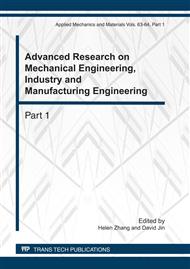p.377
p.381
p.385
p.390
p.395
p.399
p.403
p.407
p.412
Blind Signal Separation of Strong Reverberation Based on a New Algorithm
Abstract:
The major problem of blind source separation in frequency domain is the permutation ambiguity between different frequency bins, which is the key factor to recover the original sources correctly. A new idea is to consider the frequency components from the same source as a multivariate vector with a certain probability density function, and the vectors from different sources are independent each other. An algorithm based on this idea is proposed to solve the permutation ambiguity problem of BSS in frequency domain, and some approximate cost functions are compared with the existing algorithm in frequency domain. The computer simulations to two true speeches with strong reverberation are shown to verify the efficiency of the proposed algorithm.
Info:
Periodical:
Pages:
395-398
Citation:
Online since:
June 2011
Authors:
Price:
Сopyright:
© 2011 Trans Tech Publications Ltd. All Rights Reserved
Share:
Citation:


